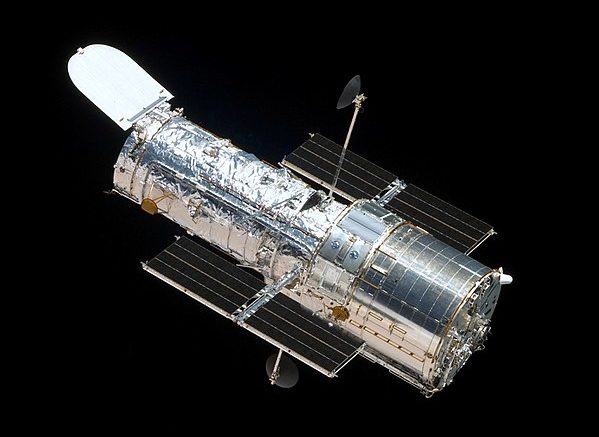Named after astronomer Edmund Hubble, the Hubble Space Telescope launched on April 25th, 1990 from shuttle Discovery. At its launch and deployment, the telescope weighed approximately 25,000 pounds, 11,355 kg. The first image taken by Wide Field/Planetary Camera was released May 20. This is not an exhaustive study or history, but rather some quick highlights of one of the most famous telescopes in modern history!
What Is Hubble Space Telescope?
The Hubble Space Telescope is a telescope that orbits Earth with a 2.4-meter, 7.9 foot, mirror and four main instruments observe in the ultraviolet, visible, and near infrared regions of the electromagnetic spectrum. This orbit outside of the distortion of the atmosphere allows the telescope to take extremely high-resolution images with substantially lower background light than ground-based telescopes.
History Of Hubble Space Telescope
Shortly after launch, scientists discovered that Hubble Space Telescope had an in issues, NASA sent up a NASA space shuttle crew to fix the issue. Hubble remains one of the only satellites ever to have been fixed by astronauts while in space.
Instruments have been added and removed from Hubble. Currently, there are 4 instruments on the telescope, with the NICMOS kept in hibernation. The NICMOS may be revived if WFC3 were to fail in the future.
- Advanced Camera for Surveys (ACS; 2002–present)
- Cosmic Origins Spectrograph (COS; 2009–present)
- Wide Field Camera 3 (WFC3; 2009–present)
- Near Infrared Camera and Multi-Object Spectrometer (NICMOS; 1997–present, hibernating since 2008)
Important Discoveries Made By Hubble
The Hubble Space Telescope has been part of numerous breakthroughs, too many to discuss in this quick review, but the following are some of them.
- Age of the universe
- Expansion of the universe
- Black holes
- Extending visible wavelength images
- Solar system Discovery
- Supernova Reappearance
- Mass and Size of Milky Way
Legacy Of Hubble
In addition to the wealth of scientific data that the Hubble has produced, the Hubble Space Telescope has produce a treasure trove of images that has captured the public imagination. Although technology has advanced since its creation and has surpassed its imaging in some areas, the Hubble has and continues to provide high quality images. These images are awe inspiring and are able to capture imaginations that can result in increased science literature, which can have profound effects on society.
Theoretically, anyone can apply for time on the telescope as there are no restrictions on nationality or academic affiliation. However, funding for analysis is only available to US institutions as competition for time on the telescope is intense, with about 1/5th of all proposals submitted in each cycle earning time on the schedule. It looks like due to budget cuts, further amateur proposals with scientific merit have been unable to be further carried out.
Future Of Hubble
Extended until 2021, the plan for the Hubble Space Telescope is to have the spacecraft burn up in orbit. However, the original plan that NASA had was to retrieve the Hubble pace Telescope using a now retired space shuttle and then display the telescope in the Smithsonian Institution.
There is no direct replacement to Hubble as an ultraviolet and visible light space telescope, because near-term space telescopes do not duplicate Hubble’s wavelength coverage (near-ultraviolet to near-infrared wavelengths), instead concentrating on the farther infrared bands. Although considered its successor, the James Webb Telescope has a very different mission, which is to observe the most distant objects in the universe, beyond the reach of existing instruments. A more direct successor is in the works, but is still in the design stages without funding.

Be the first to comment on "Hubble Space Telescope At 30"